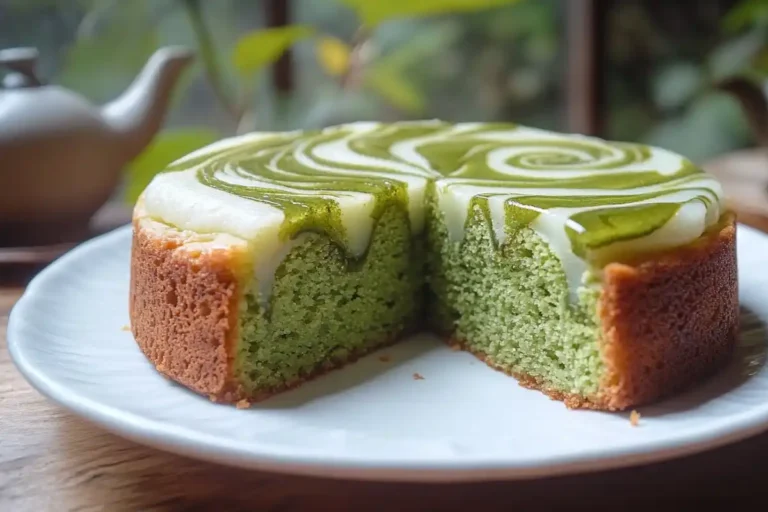Looking for a dessert that’s chewy, creamy, and totally unique? Meet the Matcha White Chocolate Mochi Cake—a delightful twist on traditional mochi, blending the earthy bitterness of matcha green tea with the sweet, creamy richness of white chocolate. This dessert brings together Japanese tradition and modern baking trends, offering an unforgettable texture and flavor combo in every bite.
In this article, we’ll explore everything you need to know about this trendy treat—from its cultural roots to expert baking techniques and common pitfalls like why matcha turns brown in the oven. Whether you’re a seasoned baker or a curious foodie, you’ll discover recipe secrets, flavor pairing tips, and creative customizations to elevate your mochi cake game.
Table of contents
- What is Matcha White Chocolate Mochi Cake?
- Key Ingredients for Matcha White Chocolate Mochi Cake
- Flavor Harmony – Do Matcha and White Chocolate Go Together?
- Step-by-Step Recipe for the Perfect Matcha White Chocolate Mochi Cake
- Customizing Your Mochi Cake Recipe
- Why Did My Matcha Cookies Turn Brown? (And How It Relates to Mochi Cakes)
- Can I Add Matcha to Cookie Dough and Other Baked Goods?
- Serving, Storing & Enjoying Mochi Cake
- Can I Add Matcha to Cookie Dough and Other Baked Goods?
- Serving, Storing & Enjoying Mochi Cake
- Nutritional Profile and Health Perks of Matcha White Chocolate Mochi Cake
- FAQs
- Conclusion
Check out our Sweet Breakfast Recipes for more delicious ideas to satisfy your sweet tooth.
Let’s get into the magic of mochi, matcha, and white chocolate.
What is Matcha White Chocolate Mochi Cake?
Origins of Mochi and Its Evolution in Baking
Mochi originates from Japan and has been a staple in Japanese cuisine for centuries, traditionally made by pounding steamed glutinous rice into a sticky, chewy dough. Originally used in religious rituals and festivals, mochi has become a beloved dessert enjoyed globally in both sweet and savory forms.
In modern baking, mochi has evolved into a new trend—mochi cake—which uses glutinous rice flour (like mochiko or shiratamako) to replicate that same chewy texture, but with the ease of baking. The result? A cake that’s firm on the outside, sticky-soft on the inside.
This adaptation paved the way for flavor fusion, including the now-popular Matcha White Chocolate Mochi Cake.
The Rise of Fusion Desserts: Matcha Meets White Chocolate
Fusion desserts are all about bringing global flavors together, and matcha-white chocolate mochi cake is a shining example. Matcha, made from finely ground green tea leaves, has become a star ingredient thanks to its vibrant color, unique taste, and supposed health perks.
Pair that with white chocolate—a creamy, mellow ingredient that balances out matcha’s natural bitterness—and you’ve got a combo that sings in harmony. It’s no wonder cafes and food blogs can’t get enough of this bold, chewy masterpiece.
Discover great ideas like Vegan Breakfast Guide for more globally inspired fusion recipes.
What Makes Mochi Cake Unique from Regular Cakes?
Unlike traditional sponge or butter cakes, mochi cake gets its texture from glutinous rice flour, not wheat flour. This gives it that signature chewiness—dense yet pillowy, stretchy yet sliceable.
Here’s a quick comparison:
| Feature | Traditional Cake | Mochi Cake |
|---|---|---|
| Main Flour | All-purpose / cake flour | Glutinous rice flour (mochiko) |
| Texture | Light, fluffy | Chewy, elastic, soft |
| Common Fats | Butter or oil | Butter, coconut milk |
| Sweetness Level | Balanced or sweet | Slightly sweet, more earthy |
| Fusion Flavor Flexibility | Moderate | High – pairs well with Asian flavors like matcha, sesame, red bean, and coconut |
Mochi cake isn’t just a dessert—it’s an experience.
Looking for inspiration? Try Cream Cheese Filling Ideas to stuff your mochi cake with a surprise center.
Key Ingredients for Matcha White Chocolate Mochi Cake
Why Matcha Powder Quality Matters
Not all matcha is created equal. The color, flavor, and even the bakeability of your mochi cake depend heavily on the grade of matcha you use. There are two main types:
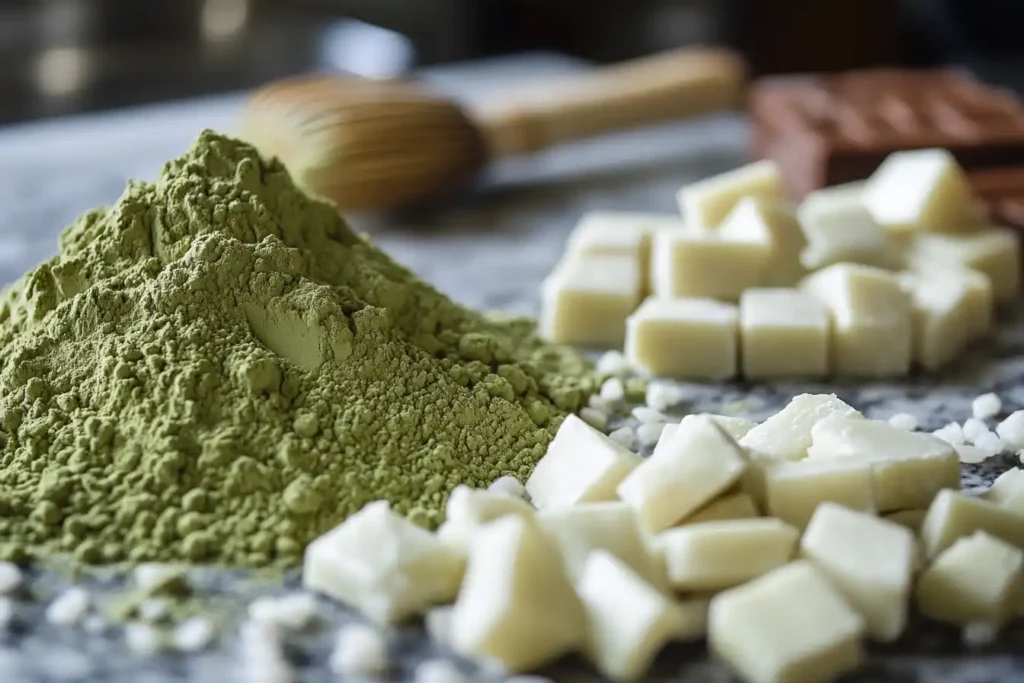
- Ceremonial Grade Matcha – Bright green, delicate, grassy, and expensive. Best used in drinks or raw applications where flavor shines.
- Culinary Grade Matcha – Slightly duller green, more robust and bitter. Ideal for baking.
For mochi cake, culinary grade matcha is the winner. It holds up better under high heat and gives your cake that signature green hue without overpowering bitterness.
✅ Pro Tip: Look for matcha with no added sugar or flavorings. A good sign of quality is a vibrant, deep green color and a fresh, grassy scent.
Choosing the Right Type of White Chocolate
White chocolate provides the creamy sweetness that balances matcha’s earthy bitterness. But don’t just grab any candy bar.
Use high-quality white chocolate with real cocoa butter (not vegetable oils or fillers). Options like Valrhona, Guittard, or Ghirardelli work beautifully. Chips or chunks are fine, but bars melt smoother.
✅ Pro Tip: Don’t use white chocolate that’s overly sweet—your mochi cake will end up cloying. Balance is key.
Glutinous Rice Flour vs. Regular Rice Flour
This is the #1 baking mistake when making mochi cake—mixing up rice flours.
- Glutinous rice flour (a.k.a. mochiko or sweet rice flour) is essential. Despite the name, it’s gluten-free and creates that signature chewy, stretchy texture.
- Regular rice flour will result in a gritty, crumbly mess.
If you’re using Mochiko (by Koda Farms) or Shiratamako (Japanese premium brand), you’re on the right track.
Here’s a quick flour guide:
| Flour Type | Texture Result | Usage |
|---|---|---|
| Glutinous Rice Flour | Chewy, stretchy | Mochi, dango, cake |
| Regular Rice Flour | Crumbly, dry | Crackers, noodles |
| All-purpose Flour | Light, non-chewy | Regular cakes |
Check out How to Make Consome de Pollo for another culturally rich recipe using traditional ingredients correctly.
Flavor Harmony – Do Matcha and White Chocolate Go Together?
Balancing Bitter and Sweet: Matcha vs. White Chocolate
One of the most common questions is: Do matcha and white chocolate go together? The answer is a resounding yes.
Matcha has natural bitterness and umami—a deep, earthy flavor. White chocolate, on the other hand, brings buttery sweetness and smoothness. Together, they create a dynamic contrast:
- Bitterness + Sweetness = Balanced flavor
- Earthy + Creamy = Comforting, rich mouthfeel
- Bright green + White swirl = Aesthetic appeal
When baked in mochi form, these flavors meld into every chewy bite—never overwhelming, always indulgent.
Cultural and Culinary Pairing Trends
In Japan and Korea, matcha-white chocolate is already a well-loved combo. You’ll find it in:
- Matcha chocolate bars
- Kit Kats (yes, the matcha version!)
- White chocolate matcha lava cakes
- Matcha lattes with white chocolate drizzle
Fusion desserts are blowing up in the US too. From matcha-white chocolate scones to mochi donuts, these two ingredients have become a culinary power couple.
Don’t miss our Berbere Spice Guide to explore more bold and unexpected flavor fusions.
Expert Opinions on Matcha-Chocolate Combinations
Chefs and food scientists have weighed in:
“White chocolate softens the bitter edges of matcha without masking its personality—making it ideal for baked goods that need structure and richness.”
– Pastry Chef Noriko Sakai, Tokyo Baking School
“Matcha has tannins, which activate taste buds differently than sweet chocolate. Paired with creamy cocoa butter, it rounds out the dessert experience.”
– Food Chemist L. Bennett, Culinary Science Weekly
So yes, it’s not only okay to mix matcha and white chocolate—it’s encouraged.
Step-by-Step Recipe for the Perfect Matcha White Chocolate Mochi Cake
Essential Tools and Equipment
Before we even mix a thing, make sure you’ve got the right tools ready:
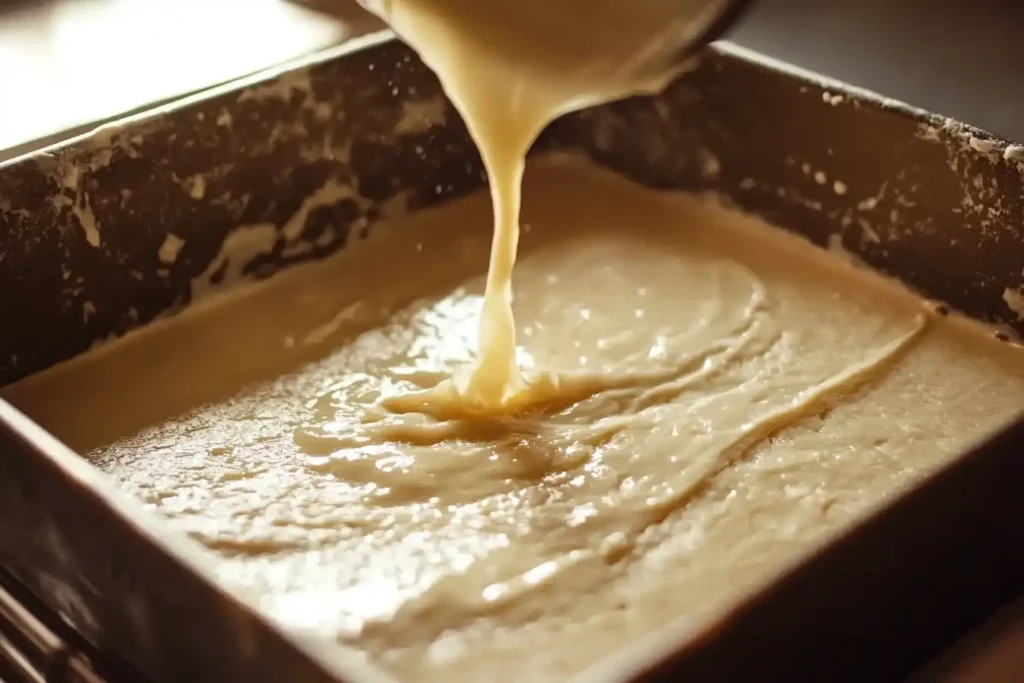
- Mixing bowls (medium and large)
- Whisk and rubber spatula
- Sifter (for clump-free matcha)
- 8×8-inch baking pan or loaf pan
- Oven preheated to 350°F (175°C)
- Nonstick spray or parchment paper
✅ Optional but helpful: Digital kitchen scale for precise flour and chocolate measurement. Remember, baking is science.
Detailed Baking Instructions
Here’s how to whip up a Matcha White Chocolate Mochi Cake that’s chewy, creamy, and melt-in-your-mouth good.
Ingredients:
| Ingredient | Amount |
|---|---|
| Glutinous rice flour (mochiko) | 1 cup |
| Sugar | ¾ cup |
| Baking powder | 1 tsp |
| Culinary grade matcha powder | 1½ tbsp |
| Whole milk or coconut milk | 1 cup |
| Eggs | 2 large |
| Unsalted butter (melted) | ¼ cup |
| White chocolate (melted) | ½ cup |
| Vanilla extract | 1 tsp |
| Salt | ¼ tsp |
Instructions:
- Preheat oven to 350°F. Grease or line your pan with parchment.
- In a large bowl, sift together glutinous rice flour, sugar, baking powder, salt, and matcha.
- In a separate bowl, whisk together the milk, eggs, melted butter, vanilla, and melted white chocolate.
- Gradually pour the wet mix into the dry mix, stirring with a spatula until smooth. The batter will be thicker than pancake batter but pourable.
- Pour the batter into your prepared pan and tap gently to remove air bubbles.
- Bake for 40–45 minutes or until a toothpick comes out mostly clean (center will be slightly soft—perfect mochi texture).
- Let it cool completely before slicing. Mochi texture sets as it cools.
🎯 Texture tip: The outer layer should be slightly firm, while the inside stays soft and chewy.
Common Mistakes to Avoid for the Best Texture
Don’t overbake. It’s not a regular cake—if you bake until fully dry, you’ll lose that mochi magic.
Avoid using regular flour. Only glutinous rice flour creates that bouncy chew.
Don’t skip the matcha sifting. Matcha tends to clump—always sift for a smoother batter and even color.
Looking for inspiration? Try Smoked Chicken Drumsticks to pair your dessert with something savory and bold.
Customizing Your Mochi Cake Recipe
Dairy-Free and Vegan Substitutes
If you’re dairy-sensitive, vegan, or just looking to lighten things up, you can absolutely make a plant-based version of this cake—without losing its chewy magic.
Substitutes that work:
| Ingredient | Swap With | Notes |
|---|---|---|
| Whole milk | Almond milk, soy milk, or oat milk | Use unsweetened for flavor balance |
| Eggs | Flax eggs (1 tbsp flax + 3 tbsp water per egg) | Helps retain structure and moisture |
| Butter | Coconut oil or vegan butter | Choose refined coconut oil to avoid coconut flavor |
| White chocolate | Vegan white chocolate chips | Look for dairy-free, cocoa butter-based options |
✅ Pro Tip: Coconut milk adds richness that mimics butter and dairy, and it complements the matcha beautifully.
Don’t miss our Cream of Mushroom Chicken if you’re balancing indulgent desserts with comforting meals.
Adding Texture: Nuts, Red Bean, or Coconut?
The mochi cake base is like a blank canvas—soft, chewy, and ready to be dressed up. Try mixing in add-ins for extra texture or layering in the center.
Add-In Ideas:
- Toasted shredded coconut – adds chew and tropical flavor
- Chopped macadamia or pistachios – crunchy, buttery contrast
- Sweet red bean paste – traditional Asian flavor, perfect in the center
- Mini mochi pieces – double the chew!
- Black sesame seeds – earthy, nutty, visually striking
Layer these into the batter or sprinkle on top before baking for extra visual appeal and bite.
Flavor Variations: Citrus, Vanilla, or Miso
Matcha and white chocolate are flexible flavors. Here’s how to elevate your mochi cake with a unique twist:
Flavor Upgrades:
| Add-On Flavor | How to Use It | Resulting Vibe |
|---|---|---|
| Lemon or yuzu zest | Add 1 tsp to wet ingredients | Brightens and sharpens flavor |
| Vanilla extract | Add up to 2 tsp for warmth | Deepens sweetness and balance |
| Miso (white) | Add ½ tsp for umami undertone | Complex, savory-sweet depth |
| Cinnamon or cardamom | Sprinkle into batter (½ tsp) | Cozy, spiced dimension |
These flavors don’t overpower—they elevate. Just a pinch goes a long way.
Learn more about savory pairings like Beef Cheek Meat Recipes to contrast your dessert’s sweetness.
Why Did My Matcha Cookies Turn Brown? (And How It Relates to Mochi Cakes)
Understanding Oxidation in Matcha During Baking
So you baked something with matcha… and it came out brownish or grayish instead of that gorgeous green. We’ve all been there.
Why it happens:
Matcha is rich in chlorophyll. When exposed to heat, oxygen, and high pH (like baking soda), chlorophyll degrades and oxidizes—resulting in brown or dull color.
This same effect can dull your mochi cake color if you’re not careful.
Baking Temperature Tips to Preserve Color
Here’s how to keep that bright green hue alive:
| TIP | WHY IT WORKS |
|---|---|
| Bake at moderate temps (325–350°F) | Slower, gentler heat preserves chlorophyll |
| Use aluminum-free baking powder | Reduces chemical reaction with matcha |
| Don’t overbake | Less heat exposure = less browning |
| Mix gently | Less oxidation from air exposure |
✅ Bonus: Add a tiny squeeze of lemon juice (acidic) to counteract the pH shift. It won’t alter flavor but can help color retention.
How to Maintain Vibrant Green in Matcha Desserts
- Use high-quality culinary matcha
- Store matcha in a dark, airtight container
- Mix your batter quickly and bake promptly
- Don’t reheat matcha-based cakes—they’ll darken
Discover more traditional cooking secrets with How to Cook Neckbones—perfect for savory lovers wanting to level up flavor and color control.
Can I Add Matcha to Cookie Dough and Other Baked Goods?
Best Practices for Using Matcha in Baking
Yes, you can absolutely add matcha to cookie dough—and more! But if you want that vibrant green color and balanced flavor, there are a few key things to keep in mind:
- Use high-quality culinary matcha for stronger color and taste.
- Start small: 1–2 teaspoons per batch of cookie dough is usually enough.
- Always sift the matcha to avoid green clumps in your cookies.
- Balance the sweetness. Matcha is naturally bitter, so increase sugar slightly or pair with white chocolate chips or vanilla to mellow it out.
✅ Want cookies that pop? Mix matcha with brown butter for a nutty twist or coconut oil for a tropical vibe.
Check out Ground Sirloin Recipes if you’re into bold flavors across sweet and savory dishes.
Matching Flavors with Matcha in Cookies
Matcha pairs well with ingredients that contrast or complement its bitter notes. Here’s a list of go-to flavors for cookie baking:
| Flavor Pairing | Description |
|---|---|
| White chocolate | Sweet, creamy balance |
| Macadamia nuts | Buttery, crunchy contrast |
| Lemon or yuzu | Bright, citrusy lift |
| Vanilla | Softens bitterness |
| Coconut | Sweet, nutty balance |
| Sesame (black or white) | Earthy, nutty match |
📌 Pro tip: Avoid dark chocolate—it amplifies the bitterness unless you want an intense matcha experience.
Popular Recipes That Work Well with Matcha
Besides cookies, matcha shines in a bunch of baked goodies. Here’s a matcha baking cheat sheet:
- Matcha Brownies – Use white chocolate or sweet condensed milk
- Matcha Muffins – Add blueberries or cream cheese filling
- Matcha Cupcakes – Pair with vanilla or strawberry frosting
- Matcha Scones – Lemon glaze is a match made in heaven
Looking to stay healthy while indulging? Go for matcha oat energy bars or vegan matcha banana bread.
Serving, Storing & Enjoying Mochi Cake
Best Way to Slice and Serve Mochi Cake
Mochi cake is best enjoyed when fully cooled—this allows the chewy texture to set perfectly.
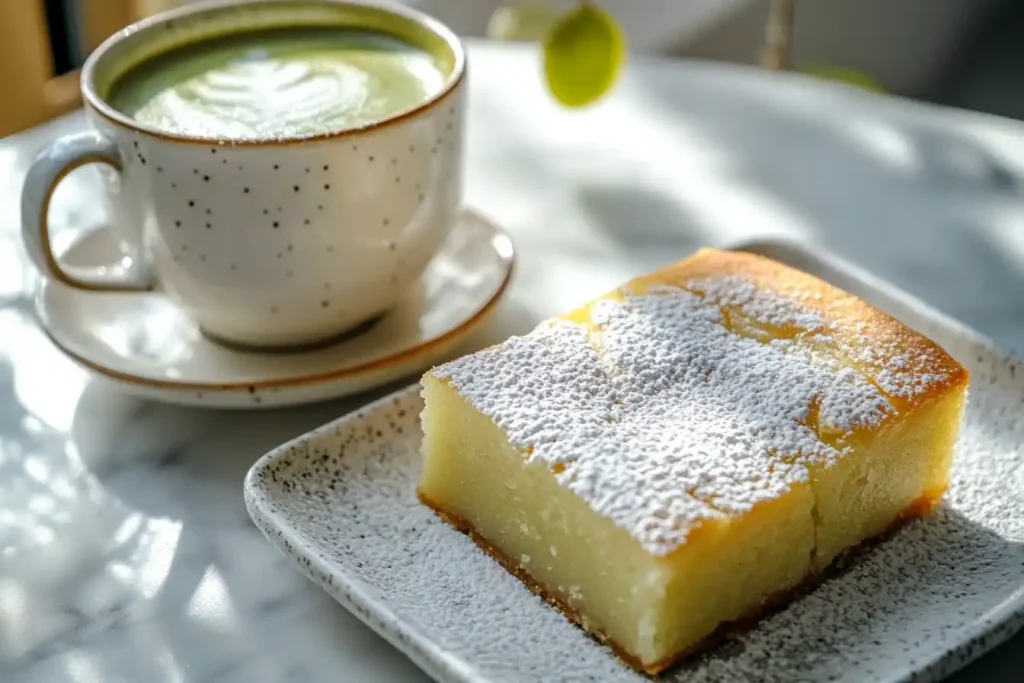
🔪 Slicing tips:
- Use a plastic knife or lightly oiled sharp knife to avoid sticking
- Wipe the knife clean between cuts for neat slices
- Cut into small squares or rectangles—this cake is rich and dense
📦 Serving ideas:
- Dust with matcha powder or powdered sugar
- Drizzle with melted white chocolate
- Serve chilled with matcha latte or iced green tea
Looking for fusion flavor ideas? Don’t miss our Zucchini Beef Fry for a bold dinner before your mochi dessert.
Storage Tips for Freshness and Texture
Because mochi is so moisture-sensitive, storing it right matters.
| Storage Method | Shelf Life | Tips |
|---|---|---|
| Room Temperature | 1–2 days | Wrap tightly in plastic wrap |
| Refrigerator | 3–4 days | Texture may firm up (still tasty!) |
| Freezer | Up to 1 month | Slice first; thaw at room temp |
✅ Texture tip: If it firms up in the fridge, microwave a slice for 10–12 seconds to bring back that soft chew.
Pairing with Drinks: Matcha Latte, Milk Tea, or Espresso?
Matcha White Chocolate Mochi Cake shines brightest when paired with the right drink:
| Drink Option | Why It Works |
|---|---|
| Matcha latte | Doubles down on earthy matcha notes |
| Hojicha (roasted green tea) | Offers warm, toasty contrast |
| Milk tea | Creamy and sweet, matches white chocolate |
| Espresso | Bitter contrast that enhances flavor |
| Sparkling water | Refreshing cleanse between bites |
Discover great ideas like Colombian Breakfast Recipes for more global meal pairings.
Can I Add Matcha to Cookie Dough and Other Baked Goods?
Best Practices for Using Matcha in Baking
Yes, you can absolutely add matcha to cookie dough—and more! But if you want that vibrant green color and balanced flavor, there are a few key things to keep in mind:
- Use high-quality culinary matcha for stronger color and taste.
- Start small: 1–2 teaspoons per batch of cookie dough is usually enough.
- Always sift the matcha to avoid green clumps in your cookies.
- Balance the sweetness. Matcha is naturally bitter, so increase sugar slightly or pair with white chocolate chips or vanilla to mellow it out.
✅ Want cookies that pop? Mix matcha with brown butter for a nutty twist or coconut oil for a tropical vibe.
Check out Ground Sirloin Recipes if you’re into bold flavors across sweet and savory dishes.
Matching Flavors with Matcha in Cookies
Matcha pairs well with ingredients that contrast or complement its bitter notes. Here’s a list of go-to flavors for cookie baking:
| Flavor Pairing | Description |
|---|---|
| White chocolate | Sweet, creamy balance |
| Macadamia nuts | Buttery, crunchy contrast |
| Lemon or yuzu | Bright, citrusy lift |
| Vanilla | Softens bitterness |
| Coconut | Sweet, nutty balance |
| Sesame (black or white) | Earthy, nutty match |
📌 Pro tip: Avoid dark chocolate—it amplifies the bitterness unless you want an intense matcha experience.
Popular Recipes That Work Well with Matcha
Besides cookies, matcha shines in a bunch of baked goodies. Here’s a matcha baking cheat sheet:
- Matcha Brownies – Use white chocolate or sweet condensed milk
- Matcha Muffins – Add blueberries or cream cheese filling
- Matcha Cupcakes – Pair with vanilla or strawberry frosting
- Matcha Scones – Lemon glaze is a match made in heaven
Looking to stay healthy while indulging? Go for matcha oat energy bars or vegan matcha banana bread.
Serving, Storing & Enjoying Mochi Cake
Best Way to Slice and Serve Mochi Cake
Mochi cake is best enjoyed when fully cooled—this allows the chewy texture to set perfectly.
🔪 Slicing tips:
- Use a plastic knife or lightly oiled sharp knife to avoid sticking
- Wipe the knife clean between cuts for neat slices
- Cut into small squares or rectangles—this cake is rich and dense
📦 Serving ideas:
- Dust with matcha powder or powdered sugar
- Drizzle with melted white chocolate
- Serve chilled with matcha latte or iced green tea
Looking for fusion flavor ideas? Don’t miss our Zucchini Beef Fry for a bold dinner before your mochi dessert.
Storage Tips for Freshness and Texture
Because mochi is so moisture-sensitive, storing it right matters.
| Storage Method | Shelf Life | Tips |
|---|---|---|
| Room Temperature | 1–2 days | Wrap tightly in plastic wrap |
| Refrigerator | 3–4 days | Texture may firm up (still tasty!) |
| Freezer | Up to 1 month | Slice first; thaw at room temp |
✅ Texture tip: If it firms up in the fridge, microwave a slice for 10–12 seconds to bring back that soft chew.
Pairing with Drinks: Matcha Latte, Milk Tea, or Espresso?
Matcha White Chocolate Mochi Cake shines brightest when paired with the right drink:
| Drink Option | Why It Works |
|---|---|
| Matcha latte | Doubles down on earthy matcha notes |
| Hojicha (roasted green tea) | Offers warm, toasty contrast |
| Milk tea | Creamy and sweet, matches white chocolate |
| Espresso | Bitter contrast that enhances flavor |
| Sparkling water | Refreshing cleanse between bites |
Discover great ideas like Colombian Breakfast Recipes for more global meal pairings.
Nutritional Profile and Health Perks of Matcha White Chocolate Mochi Cake
Calories and Macronutrients Overview
While it’s a dessert, Matcha White Chocolate Mochi Cake is surprisingly lighter than many dense cakes or brownies. Here’s a rough nutritional breakdown per square (based on 16 servings):
| Nutrient | Approximate Amount |
|---|---|
| Calories | 160–180 kcal |
| Carbohydrates | 25g |
| Protein | 2–3g |
| Fat | 6–8g |
| Sugar | 10–12g |
This cake is gluten-free (thanks to glutinous rice flour) and can be made dairy-free or vegan with a few swaps.
Antioxidants in Matcha: Real Benefits or Hype?
One of matcha’s biggest selling points is its antioxidant power, specifically catechins like EGCG, which have been linked to:
- Anti-inflammatory effects
- Boosted metabolism
- Heart health support
- Improved brain function
But here’s the catch: Baking can reduce some antioxidant activity due to heat. That said, you’re still getting more benefits from matcha-based cake than, say, a regular white cake with food coloring.
Matcha also provides a gentle caffeine kick without the jitters, thanks to the amino acid L-theanine.
Moderation Tips for Enjoying Dessert Without Guilt
Balance is key. This dessert has indulgent elements—white chocolate and sugar—but also offers:
- Smaller portion control due to its dense, chewy texture
- Less butter or oil than traditional cakes
- Mindful ingredients like matcha and rice flour
✅ Enjoy it as a mid-afternoon treat with tea, or bring it to gatherings as a unique and slightly health-leaning dessert.
Learn more about smart indulgence in our The Breakfast Burrito: Nutrition Breakdown.
FAQs
Yes! Matcha’s bitterness pairs beautifully with the creamy sweetness of white chocolate. Together, they create a balanced, rich flavor profile that’s smooth and satisfying.
Absolutely. While dark chocolate can intensify bitterness, white chocolate and milk chocolate mellow out matcha’s earthy tones, making it ideal for desserts like mochi cake, cookies, and truffles.
Matcha can oxidize when exposed to high heat, air, or high pH levels (like baking soda). This causes browning or a dull green color. To prevent it, use fresh, high-quality matcha, sift it, and bake at moderate temperatures.
Yes! Start with 1–2 teaspoons per batch, always sift it, and pair with complementary flavors like vanilla, white chocolate, or citrus. It adds a beautiful color and a unique earthy flavor to your cookies.
Conclusion
From chewy bites to creamy undertones, the Matcha White Chocolate Mochi Cake is more than just a dessert—it’s an experience. You’ve learned:
- How to choose quality matcha and chocolate
- Step-by-step baking instructions
- Ways to customize and store it
- Why it turns brown—and how to fix it
- How to use matcha beyond cake
Whether you’re baking for a brunch, potluck, or a cozy night in, this recipe delivers flavor, texture, and a touch of healthy indulgence.
Don’t miss our Sweet Breakfast Recipes for more mouthwatering ideas.
Print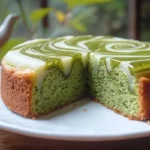
Matcha White Chocolate Mochi Cake
- Total Time: 1 hour
- Yield: 16 squares 1x
Description
A chewy, gluten-free cake combining earthy matcha and sweet white chocolate for a modern dessert twist.
Ingredients
1 cup glutinous rice flour
¾ cup sugar
1½ tbsp matcha powder
½ cup melted white chocolate
1 cup milk
2 eggs
¼ cup butter
1 tsp vanilla
¼ tsp salt
1 tsp baking powder
Instructions
Preheat oven to 350°F.
Sift and mix dry ingredients.
Whisk wet ingredients separately.
Combine and pour into greased pan.
Bake for 45 minutes. Cool before slicing
- Prep Time: 15 mins
- Cook Time: 45 mins
Nutrition
- Calories: 170
- Sugar: 25g
- Fat: 7g
- Protein: 2g

